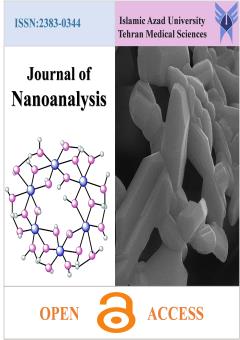Synthesis and Evaluation of the Effectiveness of Multi-component Magnetic/Carbon Nano Composite in Removing Heavy Metals from Aqueous Solutions
Subject Areas : Journal of Nanoanalysis
Alireza Vahidi
1
,
Mona Eghtefari
2
,
Fariba Tadayon
3
*
![]()
1 - Department of Chemistry, Islamic Azad University, North Tehran Branch, Tehran, Iran
2 - Department of Chemistry, Islamic Azad University, North Tehran Branch, Tehran, Iran
3 - 2Department of Chemistry, North Tehran Branch, Islamic Azad University, Tehran, Iran
Keywords: Mercury, Surface Adsorption, Magnetic Nanoparticles, Carbon nanotube,
Abstract :
Population growth, industrial development and technology transfer are among the factors of increasing water consumption and waste water production in communities and environmental pollution. Today, this pollution has become a big problem, which has made it necessary to invest in water treatment. Heavy metals are one of the most problematic and dangerous pollutants for the environment and humans. Mercury is considered as a global pollutant and a very toxic element due to its accumulation effect and high persistence in the environment. To remove toxic metals, the adsorbents that are easy and fast to separate and do not cause secondary pollution are preferred. In this study, a modified magnetic carbon nanotube has been prepared and used to remove mercury from polluted water. The physical, chemical and morphological characteristics of the adsorbent were determined with FT-IR and FESEM analyses. In the optimal conditions of pH=6, ambient temperature, 0.1 g of adsorbent, concentration of 10 ppm and time of 60 minutes, the adsorption efficiency was 96%.
[1] F. Tadayon, A. Katebi, A. Afkhami, Y. Panahi & H. Bagheri, A new potentiometric sensor based on a high-performance composite for nanomolar determination of mercury (II) in environmental samples, International Journal of Environmental Analytical Chemistry, 94(9), (2014), 901-915.
[2] Sh. Motahar, M. Saber-tehrani, P. Aberoomand Azar and F. Tadayon, Preconcentration and separation of ultra-trace amounts of mercury(ii) using ultrasound-assisted cloud point-micro solid phase extraction based on modified silica aerogel with [1-(3,5-dicholorophenyl)-3(2-ethoxyphenyl)] triazene, J. Chil. Chem. Soc., 63(4), (2018).
[3] Asoh, A. P., et al. (2023). The effects of mercury exposure on human health: A systematic review. Environmental Research, 120, 115120.
[4] Liu, B., et al. (2024). Mercury in the environment: Sources, transport, fate, and effects. Science of the Total Environment, 914, 186836.
[5] F. Tadayon, M. Saber-Tehrani and Sh. Motahar, Selective removal mercury (II) from aqueous solution using silica aerogel modified with AMTT, Korean J. Chem. Eng., 30(3), (2013), 642-648.
[6] A. Abdollahi, M. Amirkavehei, M. M. Gheisari and F. Tadayon, Trace mercury determination in drinking and natural water after preconcentration and separation by DLLME-SFO method coupled with cold vapor atomic absorption spectrometry, 16th international conference on heavy metals in the environment, Rome, Italy, September 22–27, (2012).
[7] A. Abdollahi, F. Tadayon and M. Amirkavei, Evaluation and determination of heavy metals (mercury, lead and cadmium) in human breast milk, 16th international conference on heavy metals in the environment, Rome, Italy, September 22–27, (2012).
[8] F. Tadayon and Sh. Motahar, Preconcentration of mercury in human hair by modified silica aerogel nanoparticles, Academic Research International, 2(2), (2012).
[9] Androutsi, E., & Mourkogiannis, T. (2023). Recent advances in covalently bonded ceramic/polymer nanocomposites. Progress in Materials Science, 138, 101072.
[10] Meng, Q., Liu, Z., Fu, S., & Zhu, Z. (2024). Interfacial design in 2D nanocomposites: A critical review. Chemical Society Reviews, 53, 1108-1142.
[11] Mohebpour, S., & Vahdat, S. M. (2023). Nanocomposites: A review. Materials Science and Engineering: R: Reports, 120, 1-25.
[12] Shah, T. A., & Asif, H. M. (2023). Nanocomposites in the food packaging industry: A review. Critical Reviews in Food Science and Nutrition, 63 (18), 3322-3342.
[13] Blazdell, L., & Petrova, T. (2024). Polymer nanocomposites for electromagnetic interference shielding. Nanotechnology Reviews, 13 (1), 1-20.
[14] Zhu, J., Zhu, H., & Jia, D. (2023). Biopolymer nanocomposites for biomedical applications. Progress in Polymer Science, 135, 102025.
[15] Geng, H., Zhao, S., Zhang, L., Cheng, Q., & Tang, Z. (2024). High-performance and multifunctional nanocomposites for structural health monitoring: A review. Sensors and Actuators, A: Physical, 390, 111588.
[16] Chen, S., Zhu, W., Zhao, X., Xu, J., & Yang, H. (2023). High-performance and multifunctional graphene-based nanocomposites. Journal of Materials Science & Technology, 97, 17-43.
[17] Chandrasekhar, A. V., Sreeprasad, T. S., & Gupta, N. (2024). Fullerenes and their derivatives as nanofillers in polymer nanocomposites. Progress in Polymer Science, 140, 101381.
[18] Zhu, J., Zhu, H., & Jia, D. (2023). Biopolymer nanocomposites for biomedical applications. Progress in Polymer Science, 135, 102025.
[19] Blazdell, L., & Petrova, T. (2024). Polymer nanocomposites for electromagnetic interference shielding. Nanotechnology Reviews, 13 (1), 1-20.
[20] Liu, T., Li, L., Zhou, C., & Deng, Y. (2023). Functional magnetic nanocomposites for biomedical applications. Materials Today Bio, 18, 100400.
[21] Kudrinski, E., Hernández-Vacheco, E., Muñoz-Espí, C., & Ruiz-García, J. (2023). Magnetic nanocomposites: Promising tools for hyperthermia cancer treatment. International Journal of Pharmaceutics, 656, 123823.
[22] F. Tadayon, M. Hosseini and Sh. Motahar, Nanocomposite silica aerogel activated carbon: preparation, characterization and application to remove lead(II) from aqueous solutions, Journal of the Chinese Article Chemical Society, 59, (2012).

